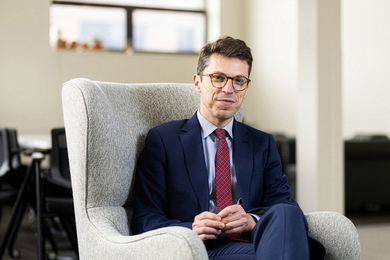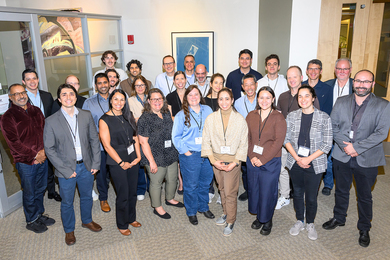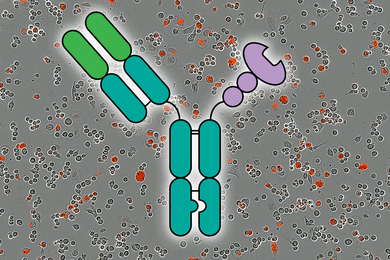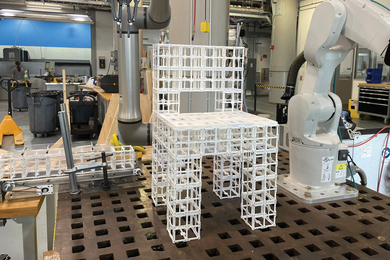President Charles M. Vest joined a select group of about 60 faculty members, students and senior officers last Friday in an intense brainstorming session on how to use a $10 million gift from Alex and Brit d'Arbeloff to support educational innovation at MIT.
The "charrette" session was divided into three one-hour segments at the Faculty Club. Charrette, the French word for cart, is used by architects to mean a fast, intensive design exercise. The usage developed because French architectural students were required to drop design papers into a cart to be delivered to their professors.
Among the participants in the charrette were Chancellor Lawrence S. Bacow, Provost Robert A. Brown, Rebecca M. Vest, Dean of Students and Undergraduate Education Rosalind H. Williams, 24 faculty members including several department heads, nine undergraduates and seven graduate students.
In summarizing the afternoons, Chancellor Bacow noted that there had been a "lot of convergence" in the recommendations made by the participants. One idea repeated by a number of participants called for more undergraduate coursework in which learning occurred through team-based problem-solving and fieldwork. Other ideas offered for discussion included a proposal that graduate students and faculty receive formal training in teaching technique, and that MIT consider tapping into research staff and the alumni/ae community as additional teaching resources.
After listening to the exchanges, President Vest said, "I was struck by the fact that, as these groups talked about what they think we need to do to build an undergraduate educational culture that stimulates and enhances excellence in education, they were talking about things we do as a matter of routine in our research culture. Maybe one of the things we can do is to break down distinctions between education culture and research culture. Perhaps we should be talking about integration between these two cultures as a way to improve education."
"The thing I'm worried most about is the scarcity of faculty time to devote both to teaching in general and to educational innovation," said Mr. d'Arbeloff (SM 1949), chair of the MIT Corporation. "But there's got to be an answer. If we don't now have enough time, money or means to pay attention to our students, our future depends upon figuring out how much it would take."
The first hour was devoted to presentations by four MIT faculty members, an expert on teaching and learning from the University of Minnesota and an MIT PhD candidate. They were Class of 1922 Professor Harold Abelson of electrical engineering and computer science; Lori Breslow, senior lecturer at the Sloan School; Associate Professor Mitchel J. Resnick of media arts and sciences; Associate Professor Ian A. Waitz of aeronautics and astronautics; Karl Smith, a professor of civil engineering at the University of Minnesota; and Rebecca Goldin, who will receive the PhD in mathematics at Commencement.
Before the participants broke into eight groups to discuss their own ideas and those offered in the presentations, they were asked to ponder two questions: (1) What is needed to strengthen education at MIT? and (2) What specific projects or efforts can be implemented in order to meet those needs?
RECURRING THEMES
The committees reported on their findings during the final hour. In noting the recurring themes among the groups, Chancellor Bacow said, "The sociologist in me wants to ask, 'Why did that happen?' Was it because of the way the issues were framed by our pre-senters? Was it because there is already considerable agreement on the approaches we need to take to improving education at MIT?"
He cited the following themes:
- ������Think big, and work for genuine cultural change. "If we think in incremental terms, then we will be squandering our resources and have little to show for our efforts."
- ������Find ways to encourage and support more active engagement of students in the process of their own education.
- ������Embrace opportunities for "discovery-based" learning, i.e., field camps, practice schools and competitions. "We should strive through these and other means to bring the real world into the classroom and take the learning process into the real world."
- ������Broaden the teaching base by providing formal training in teaching to graduate students, and perhaps by making use of research staff and alumni/ae.
- ������Create learning spaces on campus that are better suited to an innovative curriculum.
- ������Assess every new venture. "We should not undertake any new initiatives unless we know in advance how to assess their impact on students and the learning the process."
"What we did not hear was also interesting," he said, noting that technology was not mentioned, "showing that while new technology may have helped raise some of the issues, or may aid in the implementation of change, the focus is on learning and teaching."
Little mention was made of graduate education, although aspects of graduate education seem to be relevant to the discussion.These include learning in small, task-oriented teams; direct interaction with faculty and the coupling of research and learning.
"We also didn't hear much about lifelong learning and 'just-in-time' learning even though those are hot areas for development of educational innovation," added Woodie C. Flowers, the Pappalardo Professor of Mechanical Engineering.
The principles and proposals generated by the charrette will be turned over to a grants selection committee chaired by Chancellor Bacow. The committee will solicit and provide funding for projects designed to foster excellence and innovation in education at MIT.
A version of this article appeared in the May 19, 1999 issue of MIT Tech Talk (Volume 43, Number 31).





